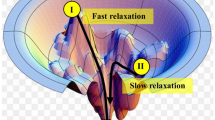Summary
In comparing it with the mechanistic and vitalistic views, the author seeks to make clear the nature of holistic causality, referring toDonnan's equations as an example.
Holistic causality is essentially dimensional simplification. A complex system which forms a whole must be described in the first instance autonomo-phenomenologically, and if possible mathematically. Thereafter it is simplified into other wholes of less dimensionality, through progressive elimination of its higher dimensions, and so on until there remain over constituents no longer showing „wholeness”. These are called „atoms” in the general sense. In holistic thought we do not begin with the atom; it is found at the end of the process of simplification.
All unitary systems which lie between the atoms — the ultimate terms of holistic simplification, no longer showing wholeness — and the highest world-whole which we call the universe, are relative wholes. Each of these unitary systems is a complete whole only with respect to those systems of lower dimension into which it can itself be simplified. On the other hand it is itself a partial whole in relation to the wholes of higher dimension to which it is subordinated. Accordingly all these systems are at the same time complete wholes and partial wholes.
It follows from this principle, as indeed theDonnan equations show, that theoretical biology can be simplified into the complementary (Bohr) domain of theoretical physics, but that it is quite impossible to „deduce„ the principles and theorems of theoretical biology from those of theoretical physics, as all mechanistic doctrines maintain.
Résumé
L'auteur, en discutant les points de vue mécanistes et vitalistes, cherche à définir la causalité holistique tout en se référant aux équations deDonnan, qu'il prend comme exemple.
La causalité holistique est essentiellement une simplification dimensionnale. Un système complexe, constituant une totalité, doit être décrit avant tout de façon autonomo-phénoménologique et — si possible — de façon mathématique. Ensuite il est simplifié de manière à former d'autres totalités de dimensionalité inférieure par suite de l'élimination progressive de ses dimensions supérieures et ainsi de suite jusqu'à ce qu'il n'en reste plus que les parties ne formant plus totalité. Celles-ci s'appellent „atomes” dans le sens propre du mot. Dans le holisme on ne commence pas par l'atome, qu'on trouve au contraire à la fin de la simplification.
Tous les systèmes constituant une totalité et se trouvant entre les atomes en tant que restes de la simplification holistique, qui ne possèdent plus un caractère de totalité, et d'autre part la totalité mondiale la plus élevée, appelée Univers, sont des totalités relatives. Tout système constituant de cette façon une totalité, ne forme une totalité complète que pour ceux-là des systèmes de dimensions inférieures dans lesquels il peut être simplifié lui-même; par contre il constitue lui-même un membre-totalité pour les totalités de dimensions supérieures auxquelles il est luimême subordonné. Ainsi tous ces systèmes sont en même temps membres-totalités et totalités complètes.
Il s'ensuit de ce principe, que, comme le démontrent aussi les équations deDonnan, la biologie théorique peut bien être simplifiée dans les domaines qui lui sont complémentaires (Bohr) de la physique théorique, mais qu'il est complètement impossible de dériver les principes et les théorèmes de la biologie théorique de ceux de la physique théorique, comme le prétendent toutes les doctrines mécanistes.
Similar content being viewed by others
Literaturverzeichnis
Beurlen, Karl, 1936. Das Gestalproblem in der organischen Natur. Z. f. d. ges. Naturwissenschaft, Jg 1, H. 11.
Bohr, Niels, 1931. Atomtheorie und Naturbeschreibung. Berlin.
—, 1933. Licht und Leben. Die Naturwissenschaften, Jg. 21, S. 245 ff.
Bunge, G. v., 1889. Lehrbuch der physiologischen und pathologischen Chemie. 2. Aufl., Leipzig.
Bünning, Erwin, {dy1935}. Sind die Organismen mikrophysikalische Systeme? (Entgegnung anP. Jordan). Erkenntnis, Bd. 5, H. 5.
—, 1936. Kritische Betrachtungen zum Holismus. Acta Biotheoretica, Vol. 1, pars 3, S. 173–184.
Driesch, Hans, 1936. Zur Kritik des „Holismus”. Acta Biotheoretica, Vol. I, pars 3, S. 185–202.
Elze, 1936. Besprechung vonR. Wetzel, Anatomie als Wissenschaft vom Menschen, Jena, 1935. In: Klinische Wochenschrift, Jg. 15, 1936, Nr. 3, S. 99.
Haldane, John Scott, 1932. Die philosophischen Grundlagen der Biologie. Übersetzt vonAd. Meyer. Berlin.
Hartmann, Max, 1935. Analyse, Synthese und Ganzheit in der Biologie. Sitzber. d. Preuss. Akademie der Wissenschaften, Phys.-math. Kl., 20.
Jordan, Pascual, 1934. Quantenphysikalische Bemerkungen zur Biologie und psychologie. Erkenntnis, Bd. 4, H. 3, S. 215 ff.
Kötschau, Karl undMeyer, Adolf, 1936. Theoretische Grundlagen zum Aufbau einer biologischen Medizin. Dresden (im Druck).
Mainz, Felix, 1933. Die Sexualität als Problem der Genetik. Versuch eines kritischen Vergleichs der wichtigsten Theorien. Jena.
Meyer, Adolf, 1934a. Ideen und Ideale der biologischen Erkenntnis. Bios, Bd. 1.
Meyer, Adolf, 1934b. Die Axiome der Biologie. Nova Acta Leopoldina, N. F., Bd. 1, H. 4/5. Halle.
Meyer, Adolf, 1935. Krisenepochen und Wendepunkte des biologischen Denkens. Jena.
Schlick, Moritz, 1934. Ganzheit. Prager Kongressvortrag, Sept. 1934.
Smuts, J. C., 1935. Die kausale Bedeutung des Holismus. Sudhoffs Archiv, Bd. 27, H. 6.
Winkler, Hans, 1934. Über zweiSolanum-Chimären mit Burdonen-Epidermis. Planta, Bd. 21, S. 613 ff.
Author information
Authors and Affiliations
Rights and permissions
About this article
Cite this article
Meyer, A. Zwischen Scylla und Charybdis. Acta Biotheor 1, 203–218 (1936). https://doi.org/10.1007/BF02147640
Issue Date:
DOI: https://doi.org/10.1007/BF02147640




